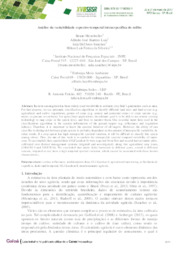Análise da variabilidade espectro-temporal intraespecífica do milho.
Análise da variabilidade espectro-temporal intraespecífica do milho.
Author(s): MONTIBELLER, B.; LUIZ, A. J. B.; SANCHES, I. D. A.; SILVEIRA, H. L. F. da
Summary: Remote sensing data has been widely used worldwide to estimate crop field?s parameters such as area. For that purpose, we use automatic classification algorithms to identify different land uses and land covers (e.g. agricultural and native vegetation), groups of crops (e.g. annual and perennial crops) or crops species (e.g. maize, sugarcane or soybean). For agricultural applications, the ultimate goal is to be able to use remote sensing technology to map crops in the specie level, and then to monitor them. One essential input data used in the classifications algorithms is the spectral information of the ground targets (e.g. reflectance and vegetation indices). Therefore, it is important to know the spectral behavior of all targets. However, the ability of one classifier to distinguish between plant species is probably dependent on the amount of intraspecific variability. In other words, if a crop specie has high intraspecific spectral variation, it will be difficult to classify this specie among others. Thus, the aim of this work is to analyze the intraspecific spectral temporal variability of maize crop. To accomplish that, spectral data (OLI/Landsat-8) were acquired from first and second harvest maize plots, cultivated over distinct management systems (irrigated and non-irrigated), along two agricultural crop years, (2014/2015 and 2015/2016). We concluded that maize fields harvested in different years, sowed in different seasons, irrigated or not, have a high temporal spectral variation, which cannot be associated with these known characteristics.
Publication year: 2017
Types of publication: Paper in annals and proceedings
Unit: Embrapa Environment
Observation
Some of Embrapa's publications are published as ePub files. To read them, use or download one of the following free software options to your computer or mobile device. Android: Google Play Books; IOS: iBooks; Windows and Linux: Calibre.
Access other publications
Access the Agricultural Research Database (BDPA) to consult Embrapa's full library collection and records.
Visit Embrapa Bookstore to purchase books and other publications sold by Embrapa.

